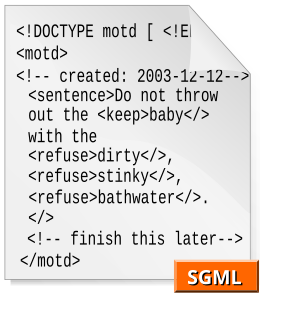
The Moving Picture Experts Group (MPEG) is an alliance of working groups established jointly by ISO and IEC that sets standards for media coding, including compression coding of audio, video, graphics, and genomic data; and transmission and file formats for various applications. Together with JPEG, MPEG is organized under ISO/IEC JTC 1/SC 29 – Coding of audio, picture, multimedia and hypermedia information.
In computing, serialization or serialisation is the process of translating a data structure or object state into a format that can be stored or transmitted and reconstructed later. When the resulting series of bits is reread according to the serialization format, it can be used to create a semantically identical clone of the original object. For many complex objects, such as those that make extensive use of references, this process is not straightforward. Serialization of object-oriented objects does not include any of their associated methods with which they were previously linked.

The Standard Generalized Markup Language is a standard for defining generalized markup languages for documents. ISO 8879 Annex A.1 states that generalized markup is "based on two postulates":

Extensible Markup Language (XML) is a markup language and file format for storing, transmitting, and reconstructing arbitrary data. It defines a set of rules for encoding documents in a format that is both human-readable and machine-readable. The World Wide Web Consortium's XML 1.0 Specification of 1998 and several other related specifications—all of them free open standards—define XML.
SAX is an event-driven online algorithm for parsing XML documents, with an API developed by the XML-DEV mailing list. SAX provides a mechanism for reading data from an XML document that is an alternative to that provided by the Document Object Model (DOM). Where the DOM operates on the document as a whole—building the full abstract syntax tree of an XML document for convenience of the user—SAX parsers operate on each piece of the XML document sequentially, issuing parsing events while making a single pass through the input stream.

JPEG 2000 (JP2) is an image compression standard and coding system. It was developed from 1997 to 2000 by a Joint Photographic Experts Group committee chaired by Touradj Ebrahimi, with the intention of superseding their original JPEG standard, which is based on a discrete cosine transform (DCT), with a newly designed, wavelet-based method. The standardized filename extension is .jp2 for ISO/IEC 15444-1 conforming files and .jpx for the extended part-2 specifications, published as ISO/IEC 15444-2. The registered MIME types are defined in RFC 3745. For ISO/IEC 15444-1 it is image/jp2.
Abstract Syntax Notation One (ASN.1) is a standard interface description language for defining data structures that can be serialized and deserialized in a cross-platform way. It is broadly used in telecommunications and computer networking, and especially in cryptography.
A document file format is a text or binary file format for storing documents on a storage media, especially for use by computers. There currently exist a multitude of incompatible document file formats.
Various binary formats have been proposed as compact representations for XML. Using a binary XML format generally reduces the verbosity of XML documents thereby also reducing the cost of parsing, but hinders the use of ordinary text editors and third-party tools to view and edit the document. There are several competing formats, but none has yet emerged as a de facto standard, although the World Wide Web Consortium adopted EXI as a Recommendation on 10 March 2011.

JSON is an open standard file format and data interchange format that uses human-readable text to store and transmit data objects consisting of attribute–value pairs and arrays. It is a common data format with diverse uses in electronic data interchange, including that of web applications with servers.
Office Open XML is a zipped, XML-based file format developed by Microsoft for representing spreadsheets, charts, presentations and word processing documents. The format was initially standardized by the Ecma, and by the ISO and IEC in later versions.
JPEG XR is an image compression standard for continuous tone photographic images, based on the HD Photo specifications that Microsoft originally developed and patented. It supports both lossy and lossless compression, and is the preferred image format for Ecma-388 Open XML Paper Specification documents.
Efficient XML Interchange (EXI) is a binary XML format for exchange of data on a computer network. It was developed by the W3C's Efficient Extensible Interchange Working Group and is one of the most prominent efforts to encode XML documents in a binary data format, rather than plain text. Using EXI format reduces the verbosity of XML documents as well as the cost of parsing. Improvements in the performance of writing (generating) content depends on the speed of the medium being written to, the methods and quality of actual implementations. EXI is useful for
This is a comparison of data-serialization formats, various ways to convert complex objects to sequences of bits. It does not include markup languages used exclusively as document file formats.
Virtual Token Descriptor for eXtensible Markup Language (VTD-XML) refers to a collection of cross-platform XML processing technologies centered on a non-extractive XML, "document-centric" parsing technique called Virtual Token Descriptor (VTD). Depending on the perspective, VTD-XML can be viewed as one of the following:
X.690 is an ITU-T standard specifying several ASN.1 encoding formats:

An XML transformation language is a programming language designed specifically to transform an input XML document into an output document which satisfies some specific goal.
ISO/IEC 20248Automatic Identification and Data Capture Techniques – Data Structures – Digital Signature Meta Structure is an international standard specification under development by ISO/IEC JTC 1/SC 31/WG 2. This development is an extension of SANS 1368, which is the current published specification. ISO/IEC 20248 and SANS 1368 are equivalent standard specifications. SANS 1368 is a South African national standard developed by the South African Bureau of Standards.





